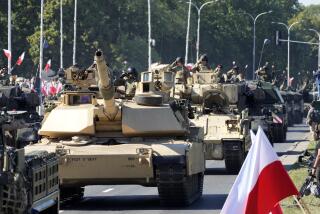Awash in New Arms, Will Readiness Sink?
- Share via
After seven years of an unprecedented peacetime defense buildup, the Defense Department is now engaged in a budgetary strategy that will either set back military readiness or create “budget-busting” defense appropriations for years to come.
The heart of this problem lies in the movement of weapon systems from the research-and-development phase to production. During the next two to three years the Pentagon wants to start production of a large number of weapon systems that have been in the R&D; stage during the 1980s. Proceeding with all these new weapons will create a “bow wave” of procurement spending that could wash away the funds required to complete current production programs, provide ammunition and spare parts for existing equipment, maintain weapons and facilities and train and pay our troops.
To avoid such a threat to U.S. military readiness, it will be necessary to set spending priorities by canceling or delaying the production of some of these weapons. If this action is not taken in the defense appropriation for 1988, the developing bow wave could quickly push defense spending well above its current high-water mark.
Funding for research and development has grown rapidly in this decade--95% after inflation between fiscal years 1980 and 1987, making it the fastest-growing part of the defense budget. The Reagan Administration wants 17.6% more after inflation for fiscal 1988. Nearly all of this increase has been to develop new hardware.
The Pentagon is developing an array of major weapon systems without setting clear priorities among them. These systems encompass the entire spectrum of nuclear and conventional weaponry--including two new fighter aircraft, a new long-range bomber, military cargo plane, helicopter, tilt-rotor aircraft, attack submarine, nuclear and conventional missiles, communication systems, an anti-satellite weapon, an aerospace plane and, of course, the Strategic Defense Initiative.
Although SDI has rapidly become the largest R&D; program, it is by no means the only source of the funding bulge. From its inception in 1984 to the current fiscal year, it has accounted for less than one-quarter of the growth in Pentagon research-and-development funding. Of the 17.6% growth that the President wants for Pentagon R&D; next year, only 4.6% is attributable to “Star Wars.”
The research-and-development costs of a weapon are a relatively small fraction of its total cost, but they lead to far greater amounts of money to produce and operate it. By promoting the development of many new weapon systems at the same time, the Reagan Administration is making down payments on new hardware that could swell later into much larger budgets for future Administrations.
The Navy’s new tilt-rotor aircraft, the V-22 Osprey, for example, is expected to cost approximately $2.6 billion to develop--not quite half of which has been funded so far. But the Pentagon wants $27 billion more, between fiscal 1989 and the end of the century, to fill its order for Ospreys, with additional billions needed for their operation and support.
Because many of the weapons now in development are set to go into production by the end of the decade, the bow wave in procurement funding is fast approaching. The Administration wants 9.4% more above inflation for the procurement of weapons in fiscal 1989 than in 1988, then 8.7% more in 1990 and 6.9% more on top of that for 1991.
One way to accommodate this demand for procurement funds would be to resume the rapid rise in the defense budget. The only other way to buy all these weapons would be to reduce the funds available for other defense needs, thus reducing the capability of U.S. forces in the 1990s by taking funds away from readiness. As new, technologically sophisticated weapons enter our arsenal, there may not be sufficient funding for maintenance, ammunition, spare parts, and pay and training of the troops that will operate them.
Though the Defense Department’s perennial problem is that it pursues more projects than it can handle, in some ways its current predicament is especially troubling.
The bow wave is approaching at a time when further significant defense-budget growth is unlikely, given the unprecedented high level of current defense spending, the need to reduce the federal deficit and the large reductions already absorbed by many domestic programs.
As Congress sets defense priorities in the appropriations bill, it has an opportunity to devise creative solutions to the bow-wave problem. If it cuts back the R&D; budget and cancels or delays some new production starts, it can preserve the readiness and capability of our military forces while being fiscally prudent. The alternative would commit us to programs that we cannot afford. Sound defense planning demands that we stop the bow wave before it breaks.
More to Read
Sign up for Essential California
The most important California stories and recommendations in your inbox every morning.
You may occasionally receive promotional content from the Los Angeles Times.











